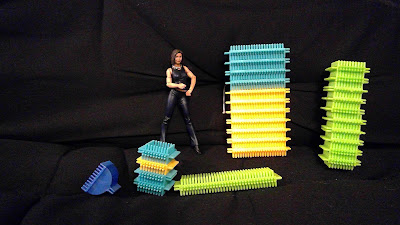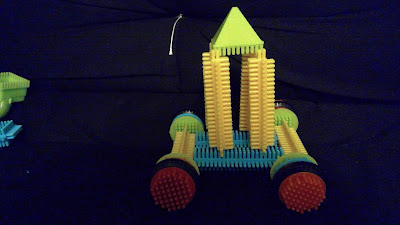It's a Monday that wasn't slated for a movie review, and I decided it was time for a different kind of mystery. In the course of retro future/ pop culture, I decided to look into the history of construction toys, a field long since dominated by Lego. That was enough to dredge up many memories of a large category of toys I have owned, played with or sighted in the wild, the knockoff/ "off-brand" building sets. Even by my standards, these things are ephemeral and usually untraceable without the clearest of recollections. The flip side is that here and there, I discovered that a notorious example was never a knockoff at all. This post will be on just one example, something a significant randomized sample of correspondents remembered seeing without any idea what they were, the Bristle Block! And here's what a highly questionable purchase got me...

But first, the backstory. By consensus, construction toys started in the late 1800s. By the 1910s, recognizable brands began to pop up such as Erector, Tinker Toys and Lincoln Logs, all made from either metal or wood. In the 1930s, plastic sets began to appear such as Bayko, Minibrix and Kiddicraft, the latter two of which suspiciously resembled designs Lego first sold in 1939. Another runnerup called Krazy Ikes, made initially of wood and later plastic, assembled into both vehicles and jointed humans and animals that approximated the action figure niche; needless to say, I have acquisitions I will be getting to. In any event, the ecosystem remained crowded but competitive through the 1960s and 1970s. It was only at the late date of 1978 that Lego inaugurated their "modern" era with the introduction of the minifigure, along with a profusion of theme sets.
Meanwhile, an unassuming inventor named Denys Fisher patented a toy called Stickle Bricks in 1969. The name appears to have passed through the hands of several manufacturers in the 1970s, before being bought up by Hasbro. The basic design was ripped off by a number of additional companies, especially Playskool, which sold them as Bristle Blocks. I have no doubt that this well-funded knockoff line accounted for the vast majority of what was circulating from the '70s into the '80s, and most of the sightings that I and others remember. It was this name that came up when I went looking, sold as "official" Bristle Blocks by a company called Battat, needless to say a familiar name to me. All of which means I bought a reissue from a manufacturer claiming to have bought out the name of what was technically the ripoff version of the toy. Hey, I'm the last one to judge. Here's a few pics of what I got with Connie.
I'm sure there's a joke I could make about bristles, but it's late...
Plus, a comparison shot I forgot until I was finishing this. These are big; Construx are still champion.
For the details, I bought all you behold for just a little over $10, billed as a 112 set for about half the price of others I saw listed. It was obvious there was going to be a catch. In fact, the big one was simply that it came in a bag instead of a box or one of the carrying cases shown with the more expensive sets. The package came with a card I saved but haven't photographed that listed the parts. It became clear from this that they had fudged the numbers by counting each of the wonky wheels as 3 pieces. That still came out at 96 pieces, which is nothing to scoff at, especially with components this big. That left the question, are these remotely functional as a construction toy? Well, here's a pic that will start to answer that...
I know, the lighting is worse than The Couch Mark 1...
As you can probably see if you take a good look, these aren't exactly as versatile as they appear. Where they might appear to be able to adhere to each other from any direction, which would be novel indeed, they do in fact have differentiated surfaces. You can still make your own choices about orientation, and if it came down to it, you could probably make most of the surfaces and edges interlock. However, results will definitely vary. It's definitely more problem-solving than you would count on from a kid at the low end of the 2+ age range given on the packaging. (Yes, I bought and am reviewing a toy literally for toddlers; have you NEVER read this blog before?...) Here's a more pics of what little Eighties kids were up against.




Now that's actually cool.
With these parameters, I gave myself about an hour to try and build something out of these. If there's any virtue to them, it is that it's not too hard to make a construction that does indeed look like a structure with a definite function. I quickly observed in the process that these are very bendy, probably to a much greater degree than vintage specimens would be. There were few if any points where this was a problem. Here are pics of my first few efforts.
Okay, so maybe "rolling temple thingy" isn't so much a function...
The most interesting thing about the set are the "topper" pieces, which were definitely not part of the vintage lines. They're nicely done, and the dome thingies would have been futuristic enough for kid me to use as parts for spaceships, superweapons and the like. Alas, it's a bit tricky to fit them on anything. Here's a quick experiment.
The Couch Mark 2 hasn't been the greatest, either.
How about something bigger? Trust me, these needed my help...
And it's still less stable than my first attempt at making my own walker...
And why not a little retro futurism???
So, it should go without saying that these things are horrid. They function only within the narrowest parameters, with perhaps slightly better than a 50% chance of sticking together in any given configuration. They barely form recognizable structures, and anything but buildings is a waste of time. As a bonus, it's impossible to look at them without immediately picturing them deeply embedded with carpet fibers, pet hair, dust, broken bits of each other and other toys, and less classifiable junk and gunk. The best thing to be said in their defense is that they always were what they clearly are, an intermediate phase between simple blocks and an actual construction set. The verdict of history is that they did their job well enough for people to remember, without inspiring anyone to do anything but leave them behind. And for the extra pic, how about a Krazy Ikes guy?
Hey, she's dated Alien, Predator, and King Kong; she's got an open mind...
That's all for now; more to come!





















No comments:
Post a Comment